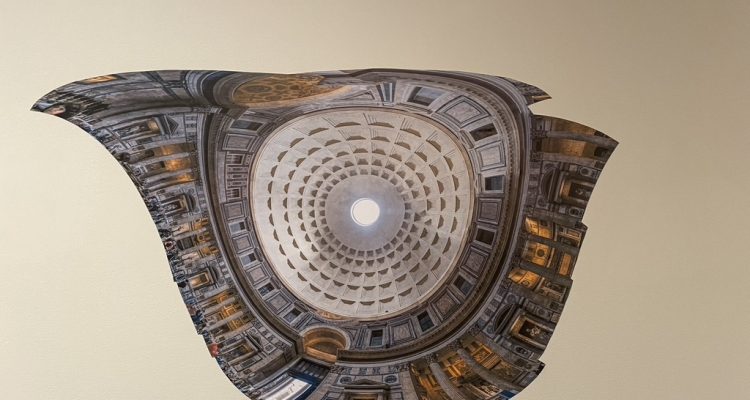In my most recent visit to the Fairfield University Art museum, I found myself particularly drawn to one exhibit: “Specimens and Reflection.” When I first glimpsed these images, resembling a spiral shape and exemplifying a variety of vibrant colors, I was intrigued.
What were these images? Could they resemble sculptures or seashells? It was their spiral nature that led me to believe they could. As I walked through the exhibit, I learned that I was completely mistaken. The more of these images I observed, the more I came to realize that these were images of architecture, specifically the interior of Roman churches.
“Specimens and Reflections” combines photography and poetry, exploring the intersection of the word and the image. Each image of a Roman church was paired with a poem in the museum.
The photographs are digitally manipulated panoramas of the interiors of Roman churches by Claudia Essingler, a professor of Art at Kenyon College. In a note displayed for visitors of the exhibit to read, Essingler explains her experiences in the over 900 churches she has visited. She writes, “The intent of the architects, artists and patrons to inspire awe and reverence was always palpable, despite the variety of eras and styles of churches I visited.” This variety in styles of churches is most definitely exemplified in these panoramic images. As I examined each image, I noticed differences in the interiors’ colors, architecture and artistry. Some of the photographs demonstrated the intricate paintings of the churches, while others drew the eye toward the great domes on the ceilings.
Essingler explains the awe she felt while visiting these churches. She explains: “there were times when I nearly became numb from overstimulation. There were times when I entered a church past a simple façade only to find my own breath catch in awe. There were times when I sat in stillness in a pew, wondering about the journey of my own faith, how it had ebbed and changed.”
Wanting to capture her experiences appropriately and accurately in her photographic work, Essingler decided to flatten the three-dimensional landscapes of these churches into “puzzles of perception.” The way in which she constructed these panoramas creates a more distorted image, with different fragments of the churches’ interiors reaching in different directions. I believe it is this tactic of the distorted image that first led me to believe these images depicted sculptures rather than Roman churches.
Essingler defends her decision to digitally manipulate these panoramas, claiming “The overall shape of the compositions reminds me of natural history specimens where discovered artifacts twist and curl into place. Indeed, these are cultural, historical specimens that reveal detailed curiosities and purpose when examined closely. Together they weave a story of wonder experienced during my extended stay.”
It was not simply the photographs that caught my attention, but the works of poetry that accompanied each photograph. All the poetry in this exhibit is written by Royal Rhodes ‘68, a professor Emeritus of Religion at Kenyon College. In a similar note to visitors of the exhibit, he explains, “This joint project let me be drawn into these visual compositions that contort, reshape, and realign borders, perspectives, colorization, coffered domes, entablatures, the theatrical undulations of concave and convex walls.”
Alongside the images, Rhodes’ poetry is meant to reflect an underlying questioning, which he calls “faithful doubt”. Poetry, like any other art form, pushes against borders. Pushing against borders is exactly what this combination of digitally manipulated panoramas and poetry does.
“Specimens and Reflections” truly is a unique visual and intellectual experience, one that I would recommend anyone to see. This exhibit will be on display in the Fairfield University Art Museum until Dec. 17, so be sure to pay it a visit before the end of the semester.


Leave a Reply